A messy garage isn’t a character flaw—it’s a sign your storage system never caught up with your life. Recent round-ups of the best garage shelving for 2025 highlight how much ingenuity has entered this once-ignored space, from wall-mounted steel racks that hold half a ton to motorized carousels that rotate bins to waist height. Meanwhile, upgraded slatwall panels and modular cubes push capacity upward without swallowing floor space. Whether you build shelves from humble 2×4s or invest in smart LED-lit units, the common thread is treating every cubic foot—wall, ceiling, and even corners—as valuable real estate.
1. Sturdy Wall-Mounted Garage Shelving That Saves Floor Space
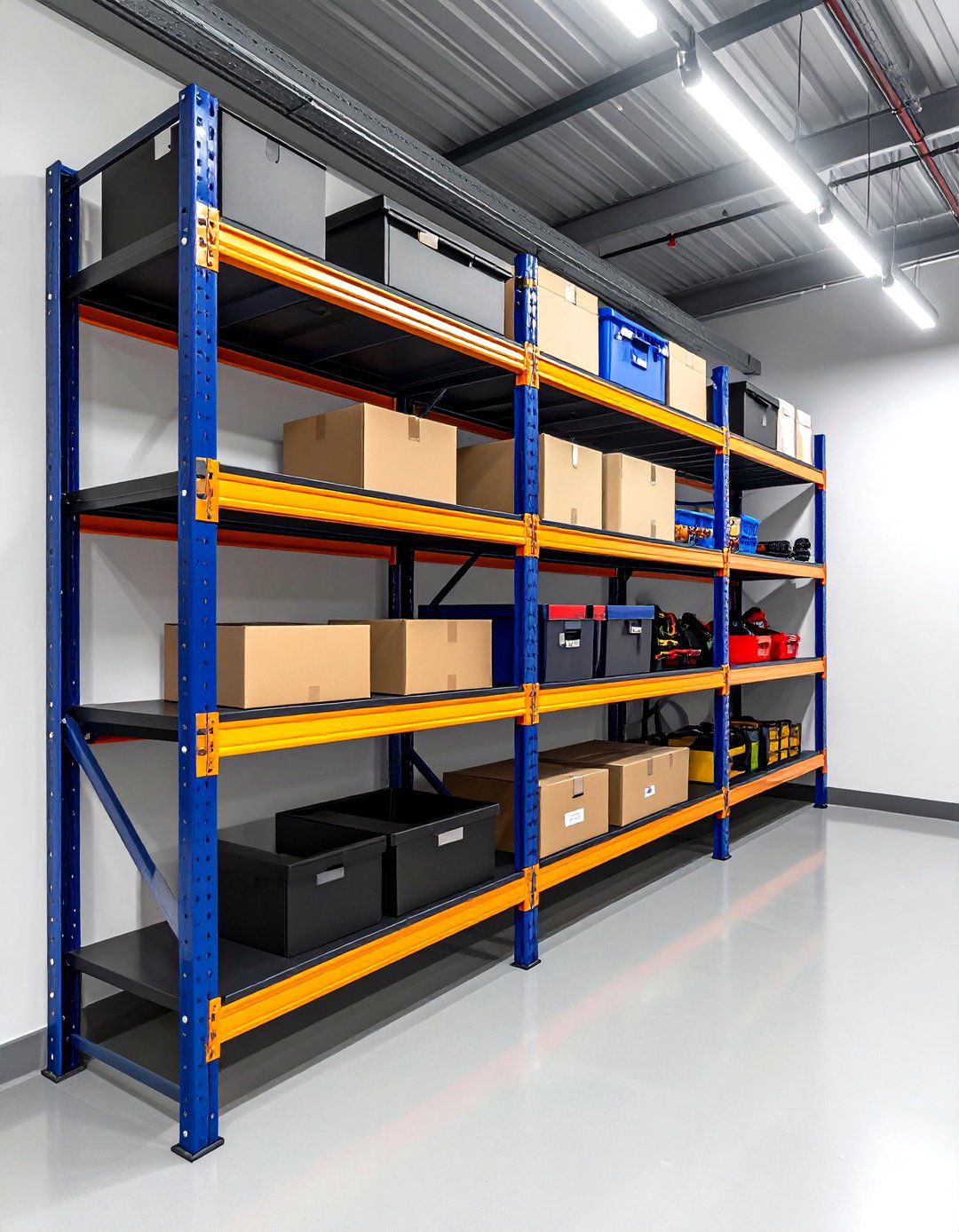
A solid wall-mounted garage shelving unit can feel like you’ve added square footage without the expense of a renovation. By anchoring heavy-gauge steel rails directly to the studs, these shelves hover above the floor, making room for lawn-mower tires and tool chests while keeping valuables out of puddles. Experts highlight that the best units support 800–1,000 pounds per bay, but the real payoff is ergonomic: supplies sit at eye level instead of stacked on the ground. Invest a few extra minutes locating studs and driving lag bolts, and you’ll gain a rugged, earthquake-resistant platform that lasts for decades and simplifies routine clean-ups.
2. DIY 2×4 Garage Shelving for Budget-Friendly Customization
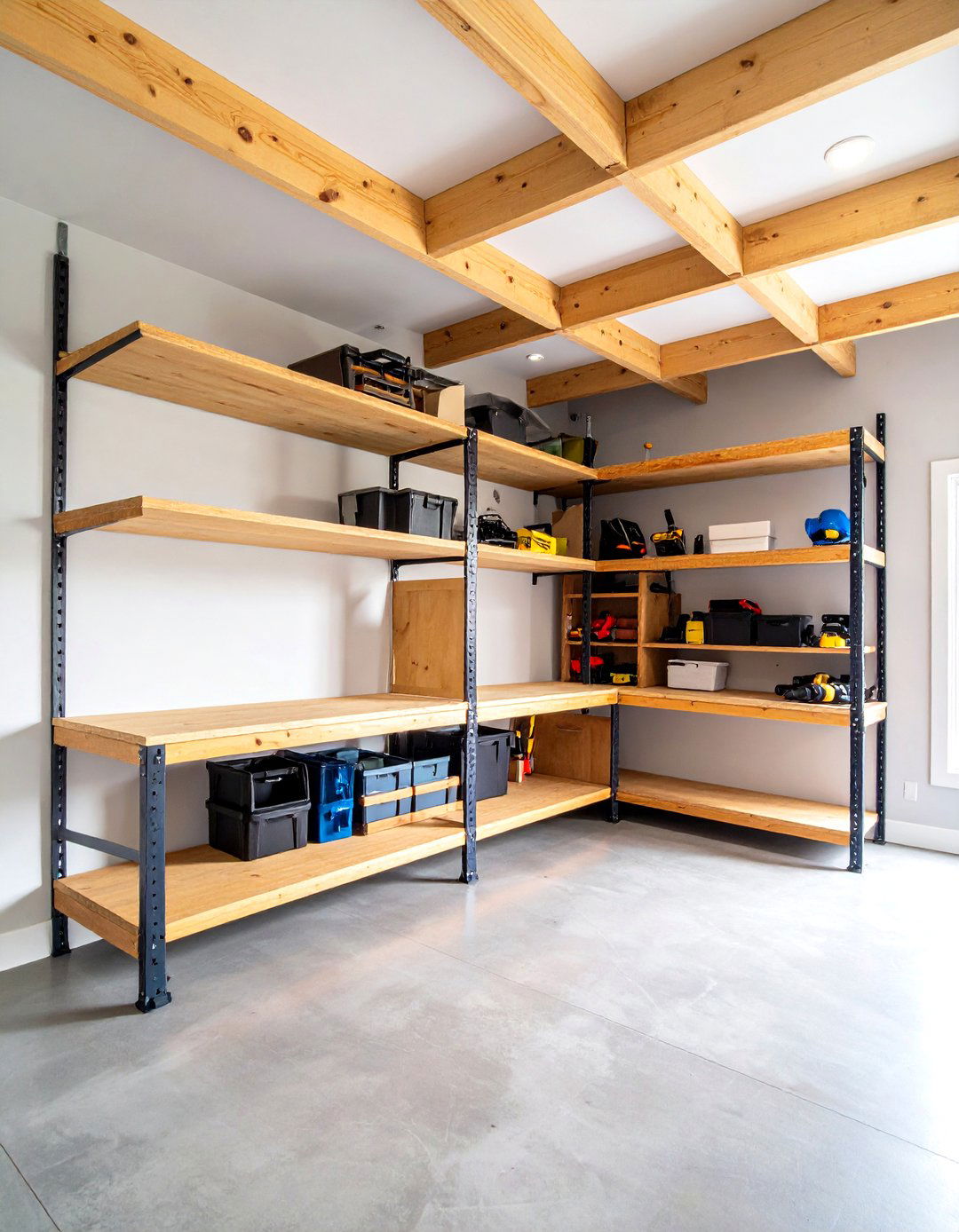
Consider DIY 2×4 garage shelving if your budget is tight yet you crave tailor-made storage. A single afternoon with a circular saw and pocket-hole jig turns construction-grade lumber into sturdy frames that fit odd corners and custom heights. The design’s genius lies in a full-depth middle ledger, which stiffens each shelf and prevents long-board sag, allowing you to pile paint cans four high without bowing. Because every joint is screwed—not nailed—you can disassemble and resize the system when your needs change. Add plywood tops sealed with polyurethane to resist oil drips, and you’ve built industrial-strength racks for the cost of takeout.
3. Adjustable Metal Garage Shelving with Ventilated Decks
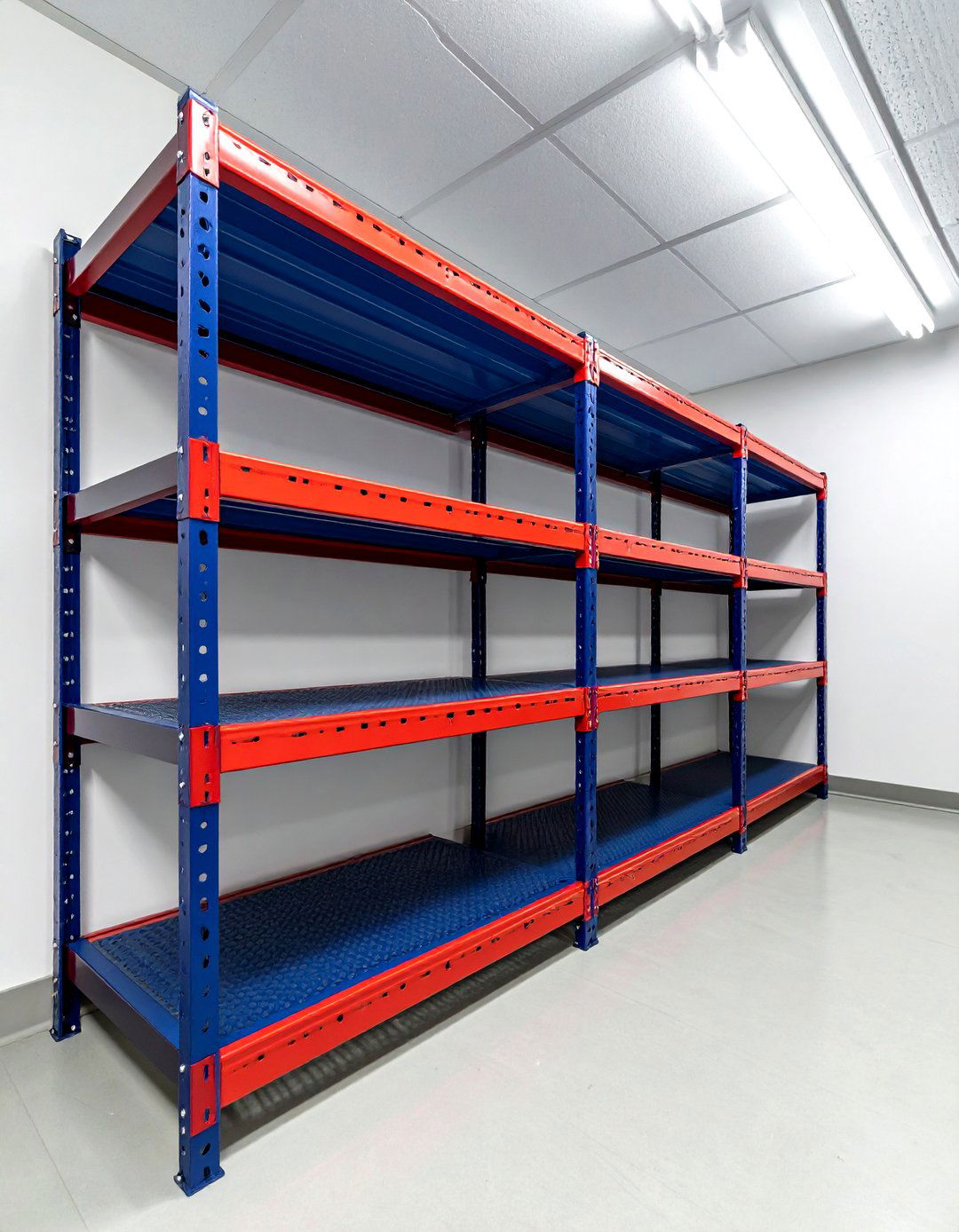
Adjustable metal garage shelving solves the classic problem of “one-size-fits-some.” Units with ventilated polypropylene or wire decks let air circulate, cutting down on mildew when you store tents or tarps still damp from adventure. Each post has punched holes every two inches; moving a shelf is as simple as popping out locking pins and sliding crossbars to a new notch. Some models even level uneven concrete by making each foot independent, so the entire frame stands firm without wood shims. When your kids graduate from trikes to mountain bikes, you can bump the lowest shelf upward and reclaim precious floor room.
4. Ceiling-Mounted Garage Shelving for Bulky Seasonal Bins
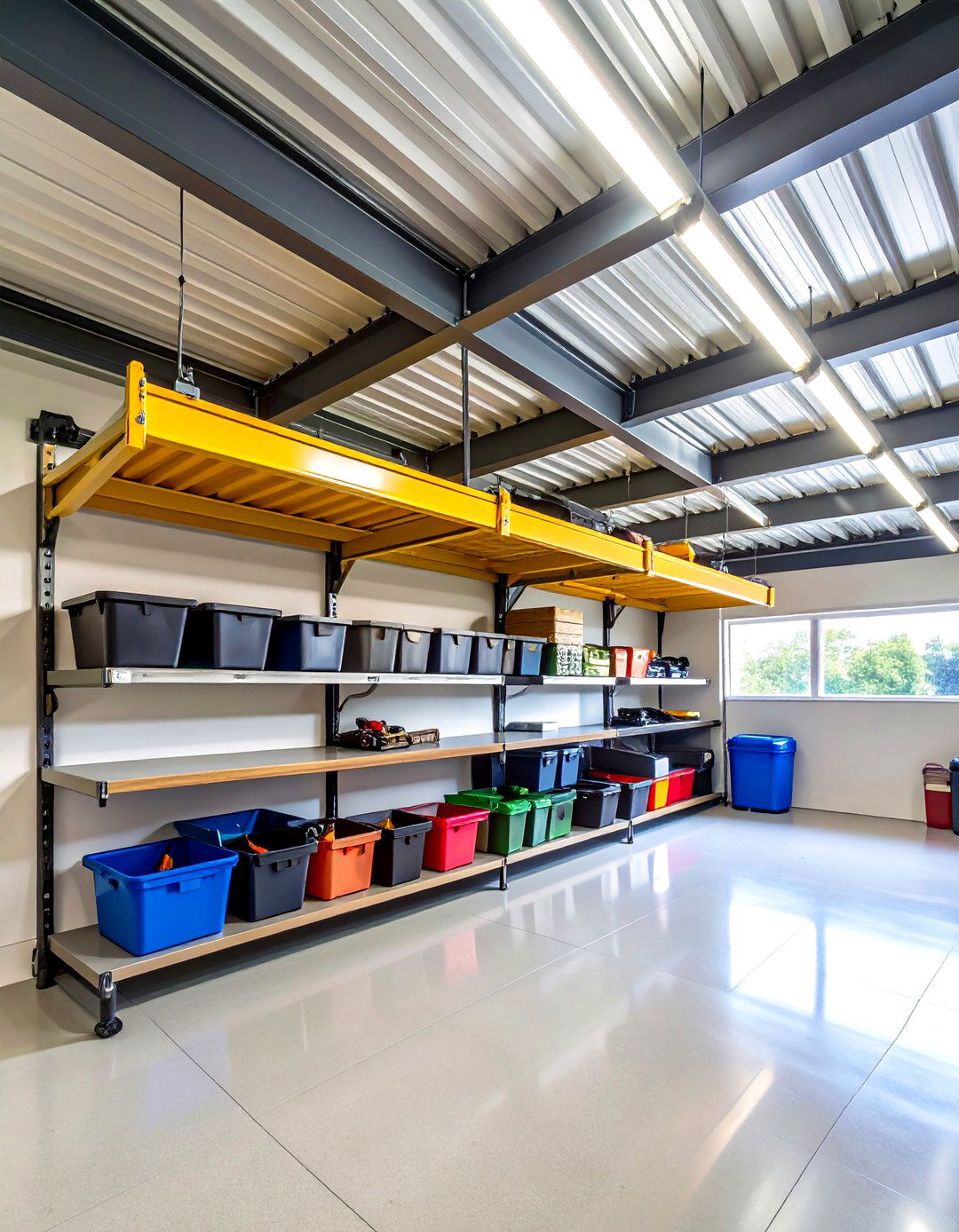
For bulky seasonal bins, ceiling-mounted garage shelving turns forgotten overhead real estate into a storage loft. Heavy-duty joist-spanning brackets drop adjustable steel frames that keep totes above car roofs yet below sprinkler lines. Installation feels intimidating, but safety boils down to four essentials: locate joists with a stud finder, mark pilot holes, use lag bolts, and grab a helper before you hoist the frame. Once secure, these racks routinely carry 600 pounds while freeing wall space for ladders. Color-coded totes slide in like drawers, so accessing holiday lights or camping gear becomes a stable, two-minute task rather than attic acrobatics.
5. Slatwall-Integrated Garage Shelving Boosts Capacity
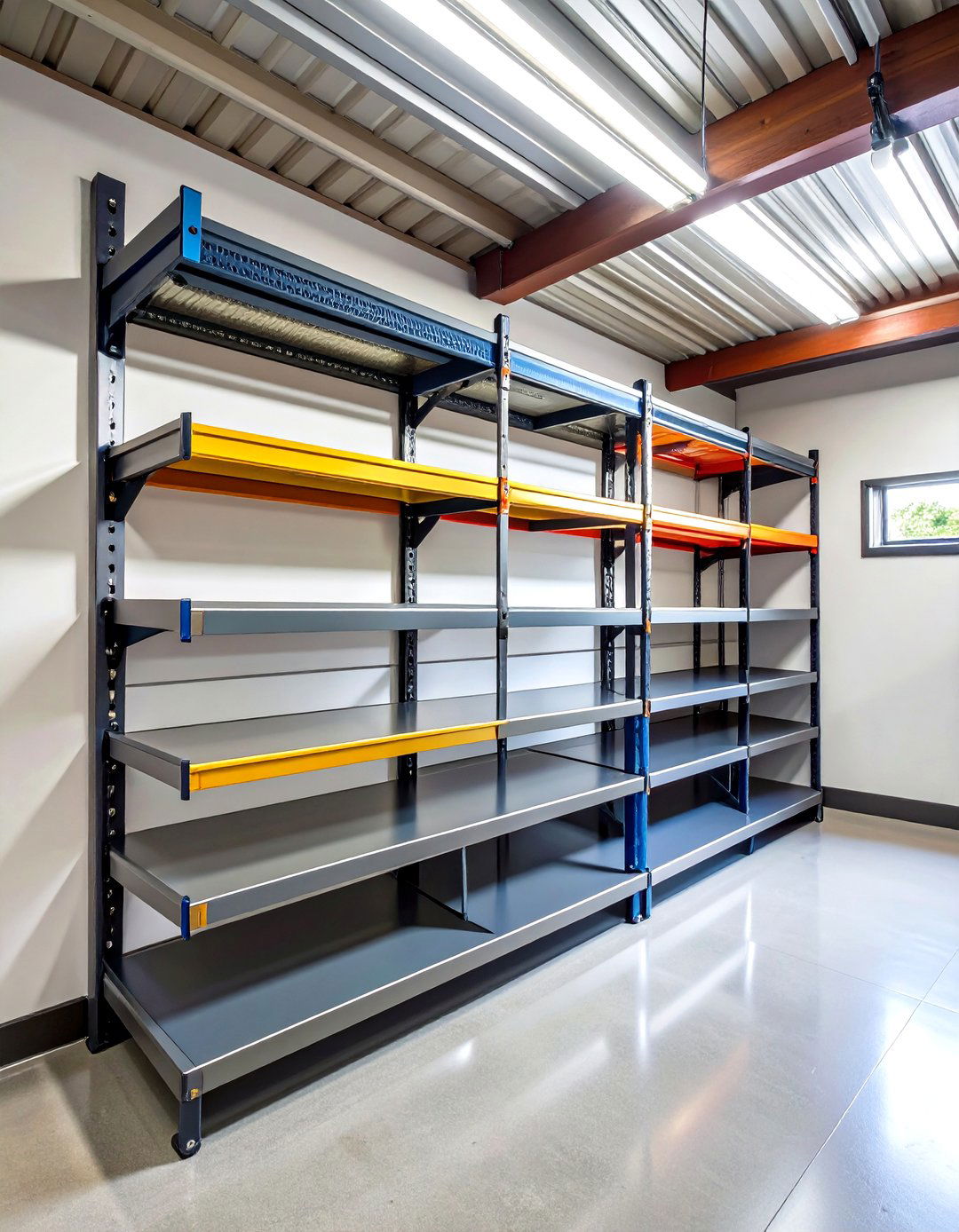
A slatwall-integrated garage shelving setup merges horizontal rails with clip-on shelf brackets to boost capacity by as much as thirty percent, according to recent storage studies. Because every bracket hooks into the same continuous panel, you can flank shelves with hooks for hoses or baskets for basketballs, creating a cohesive vertical zone that grows with your hobbies. Modern PVC and powder-coated steel slatwalls shrug off humidity and hot-weather expansion while offering finishes that mimic carbon fiber or brushed aluminum. By coordinating shelf color with panel grooves, you produce a sleek, built-in look that elevates the garage from catch-all to showcase.
6. Plastic vs. Metal Freestanding Garage Shelving Units
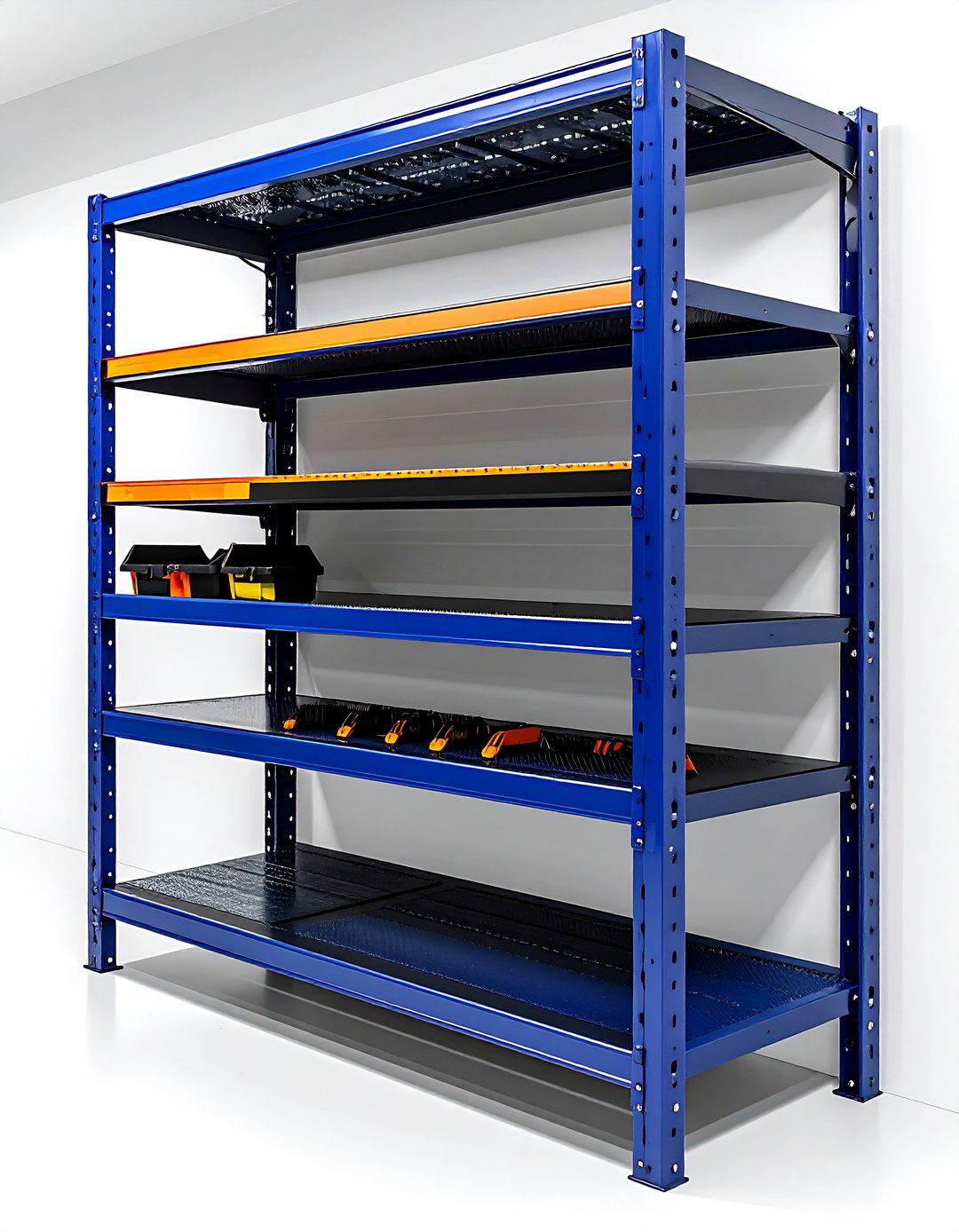
Selecting between plastic and metal freestanding garage shelving comes down to moisture, load, and mobility. High-density resin units resist rust and battery-acid drips, making them smart for car-wash supplies or pool chemicals. Steel frames, on the other hand, can shoulder four-digit weights and survive errant hammer blows but may need a powder-coat touch-up in coastal climates. If you anticipate rearranging frequently, plastic’s lighter mass wins, yet recent galvanized models feature snap-in bracing that keeps wobble at bay even when rolled outside for a driveway project. The bottom line: match shelf material to what you store, not merely to price tags.
7. Corner Garage Shelving to Capitalize on Awkward Angles
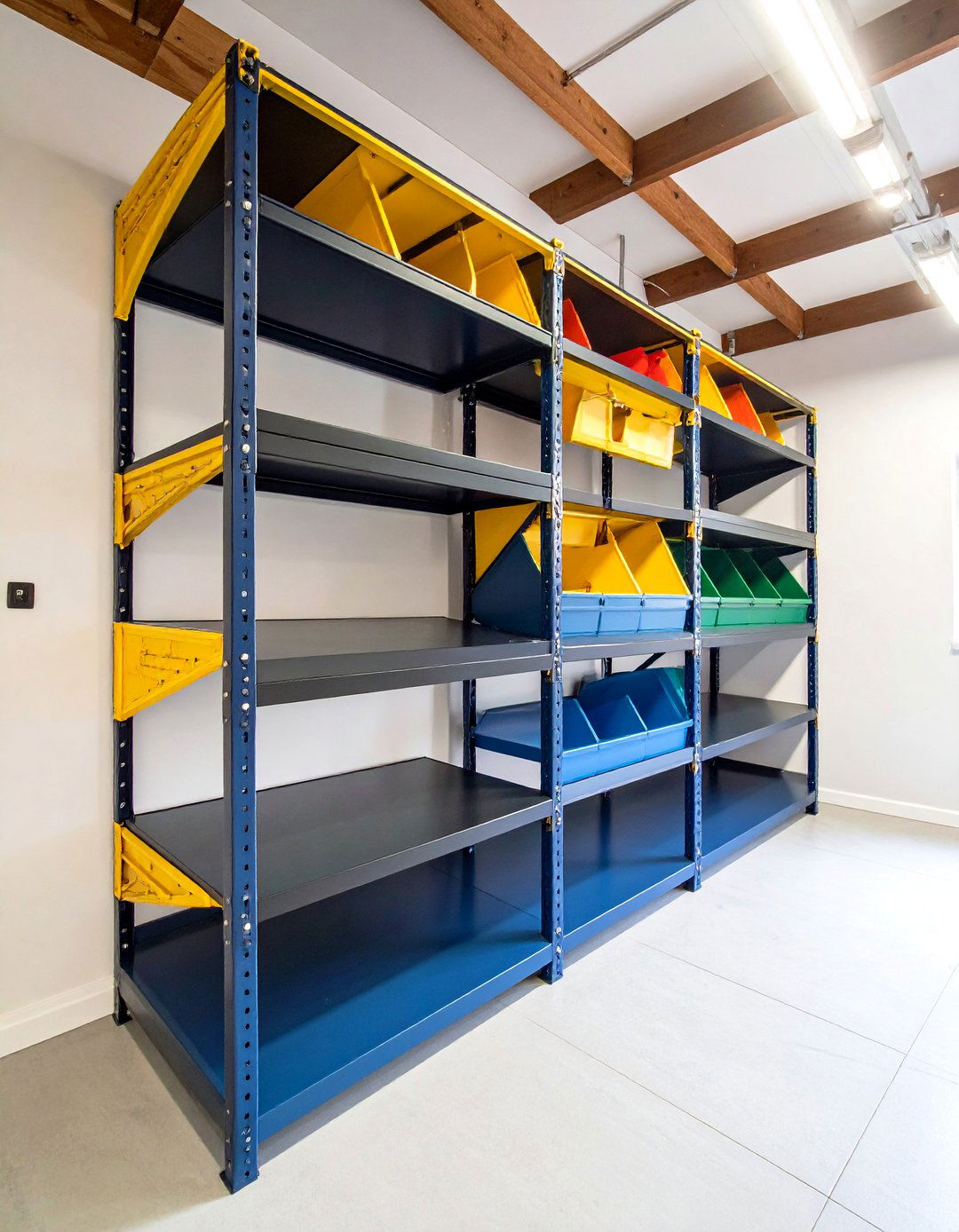
Corner garage shelving is the secret weapon against wasted nooks created where two walls meet. A triangle-shaped platform or pie-cut floating shelves let you stash motor oil, coolant, and glue bottles without blocking adjacent aisles. Because the loads naturally push toward the corner, simple cleats screwed into both walls generate surprising strength while keeping supports nearly invisible. Adding a turntable on the bottom tier gives you quick 360-degree access to spray cans and fasteners. By framing three or four vertical tiers up those voids, many DIYers recover nearly fifteen square feet of usable surface that previously gathered nothing but dust.
8. Foldable Garage Shelving for Flexible Floor Plans
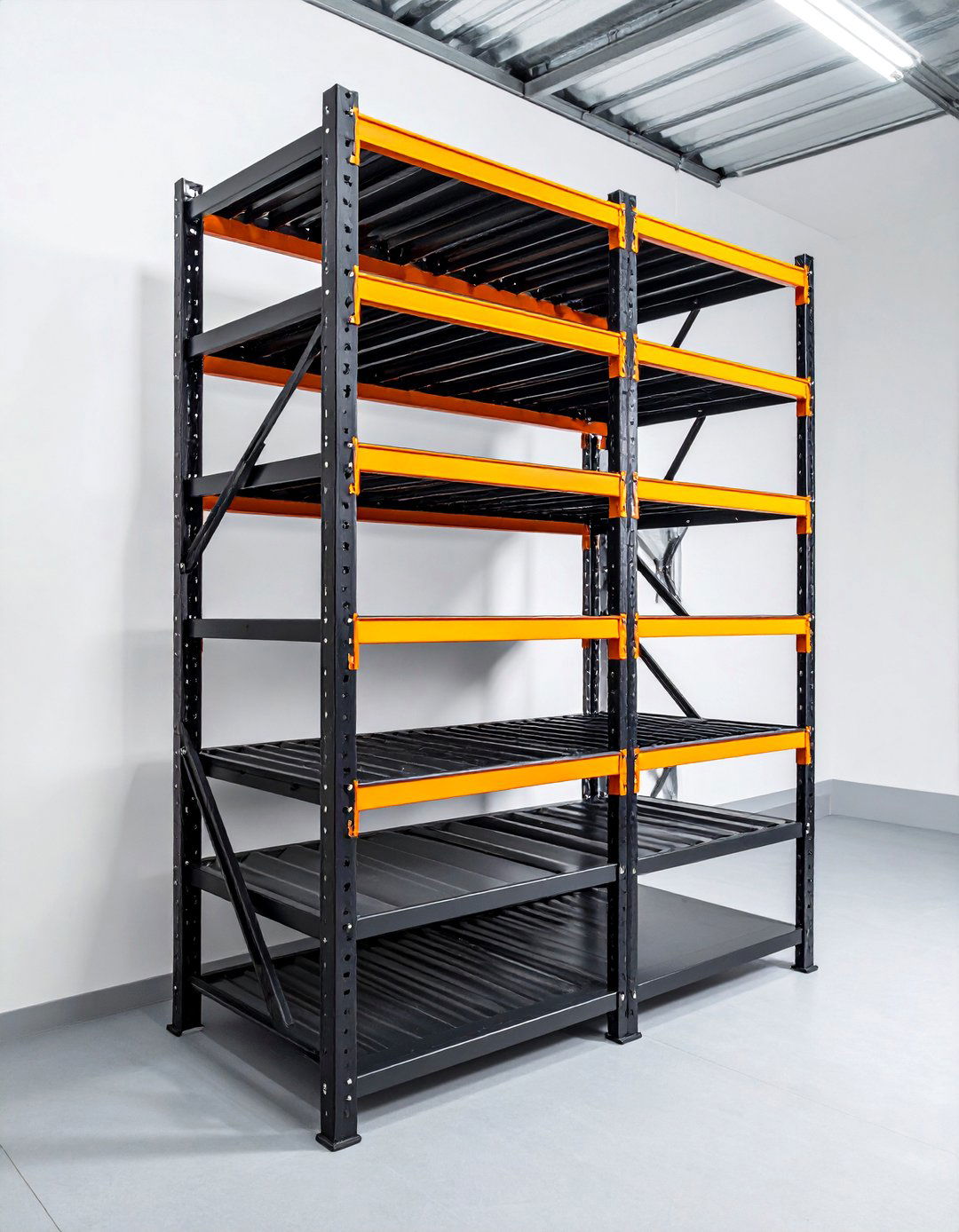
Folding garage shelving answers the call when part-time workshops need full-time flexibility. These accordion-hinged metal units arrive assembled; you merely unfold the sides, drop each shelf, and snap on locking braces. When the weekend project wraps, the rack collapses to five inches thick and wheels into a closet, returning the bay to parking duty. Weight ratings around 150 pounds per shelf make them ideal for bagged soil, paint trays, or sporting gear—not engine blocks—but they shine in multi-purpose households or rental properties where permanent anchors are off-limits. Think of them as pop-up pantries that respect square footage.
9. Mobile Garage Shelving on Locking Casters
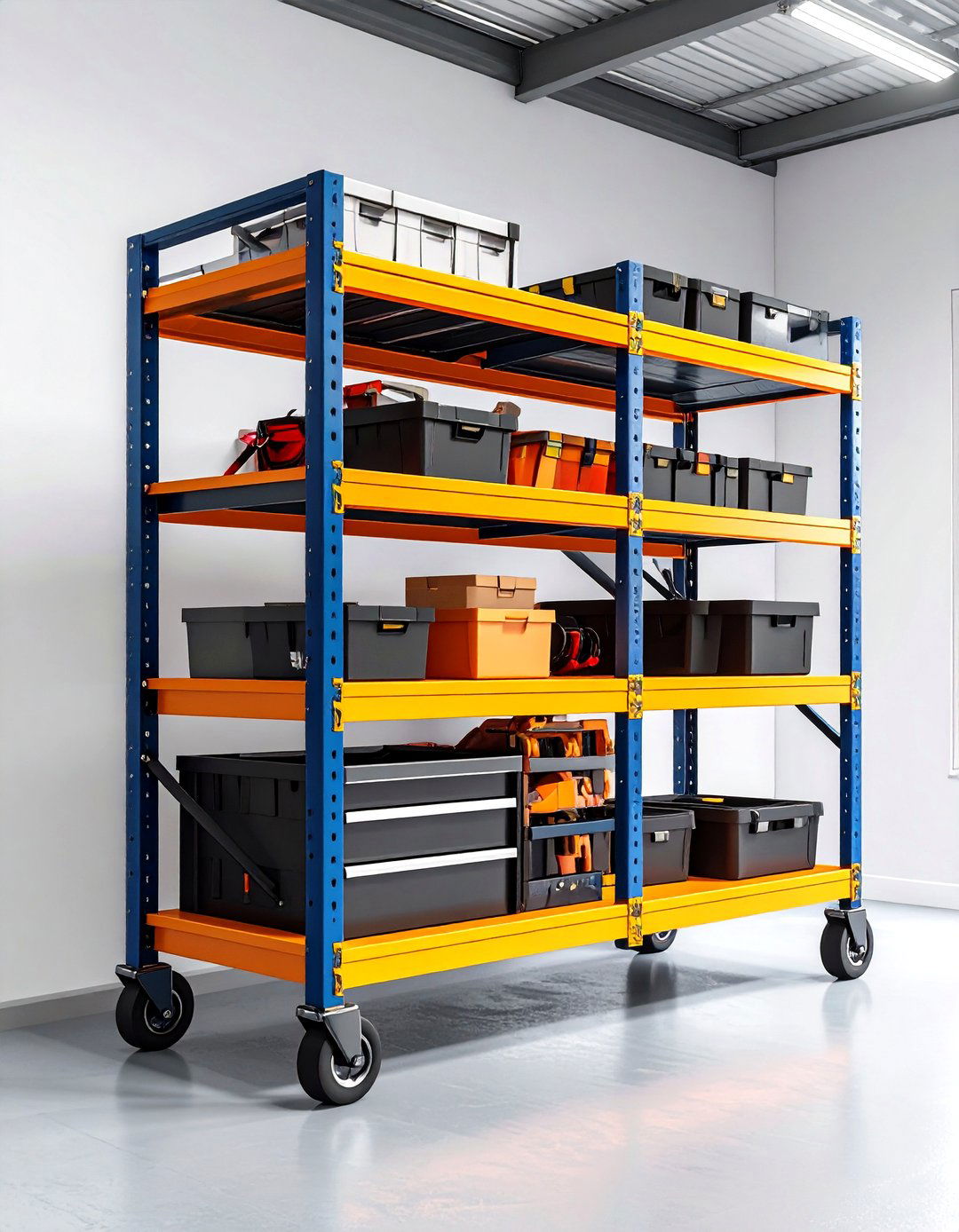
A mobile garage shelving tower on locking casters transforms storage into an adaptive workspace. Roll the rack beside your workbench to hold fasteners, then glide it toward the driveway when washing the car for instant product access. Look for industrial wheels with a two-inch tread and foot-operated brakes so the unit parks rock-solid while you torque bolts. Wire-shelf styles shed sawdust and support up to 800 pounds, yet even lighter resin frames benefit from mobility because you can vacuum debris that would otherwise fester underneath. In a one-car bay, the ability to dance shelves around obstacles feels like doubling capacity.
10. Rotating Vertical Carousel Garage Shelving for Dense Storage
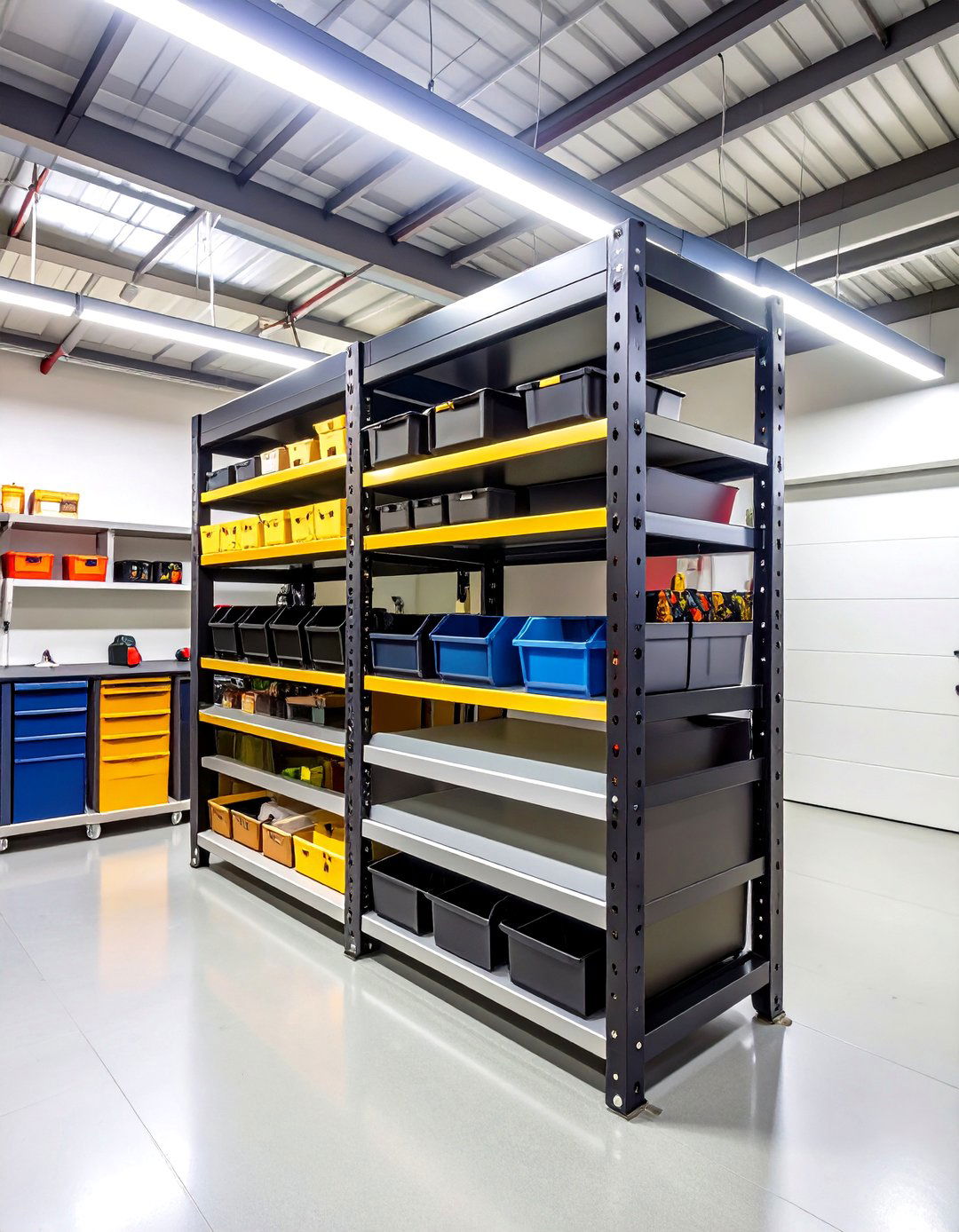
Rotating vertical carousel garage shelving brings warehouse efficiency home by stacking platforms on a motorized chain that delivers any shelf to waist height with the push of a button. The mechanism harnesses ceiling volume—often fifteen feet or more—while keeping heavy items within ergonomic reach, reducing ladder hazards. Modern carousels feature programmable stops and safety shutters that pause movement if a bin protrudes, protecting both cargo and fingers. Though the upfront cost rivals a premium toolbox, users recoup floor space and slash retrieval time when tackling frequent, small-parts tasks like woodworking hardware or detailing supplies.
11. Pegboard-Backed Garage Shelving Enhances Tool Access
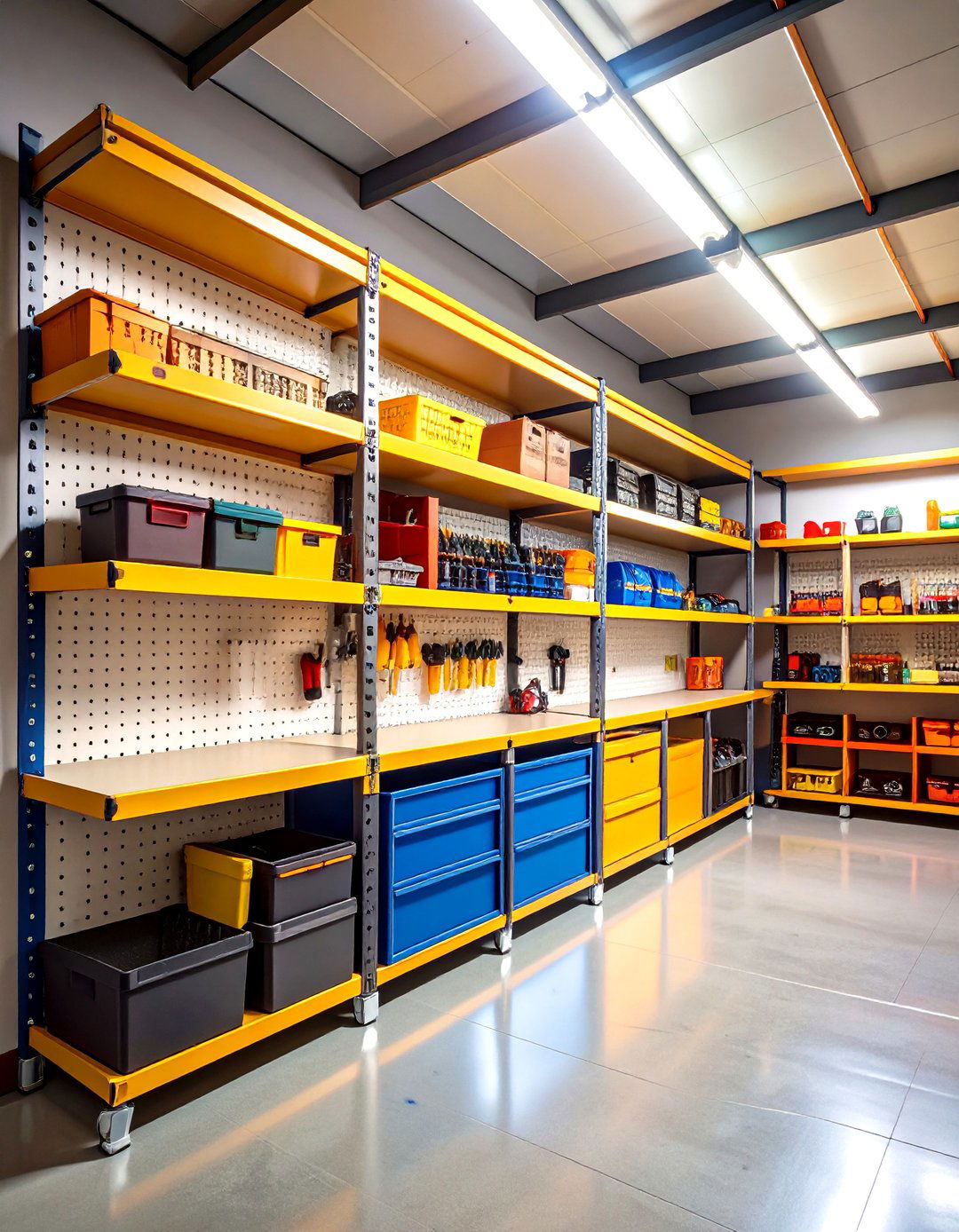
Pegboard-backed garage shelving interlocks perforated panels behind each tier, turning otherwise dead wall into customizable tool real estate. By hanging wrenches or garden shears on hooks just inches above the shelf holding drill bits, you reduce walk-and-search time. Zone planning guides advise dedicating the pegboard sweet spot—between chest and eye level—for your most-used hand tools, keeping rarities higher or lower. If you opt for powder-coated steel panels, magnetic accessories like nut-drivers stick directly without hooks, letting you shift layouts in seconds. The result is a visual inventory system that encourages fast returns and fewer misplaced pliers.
12. LED-Lit Garage Shelving for Safer Night Projects
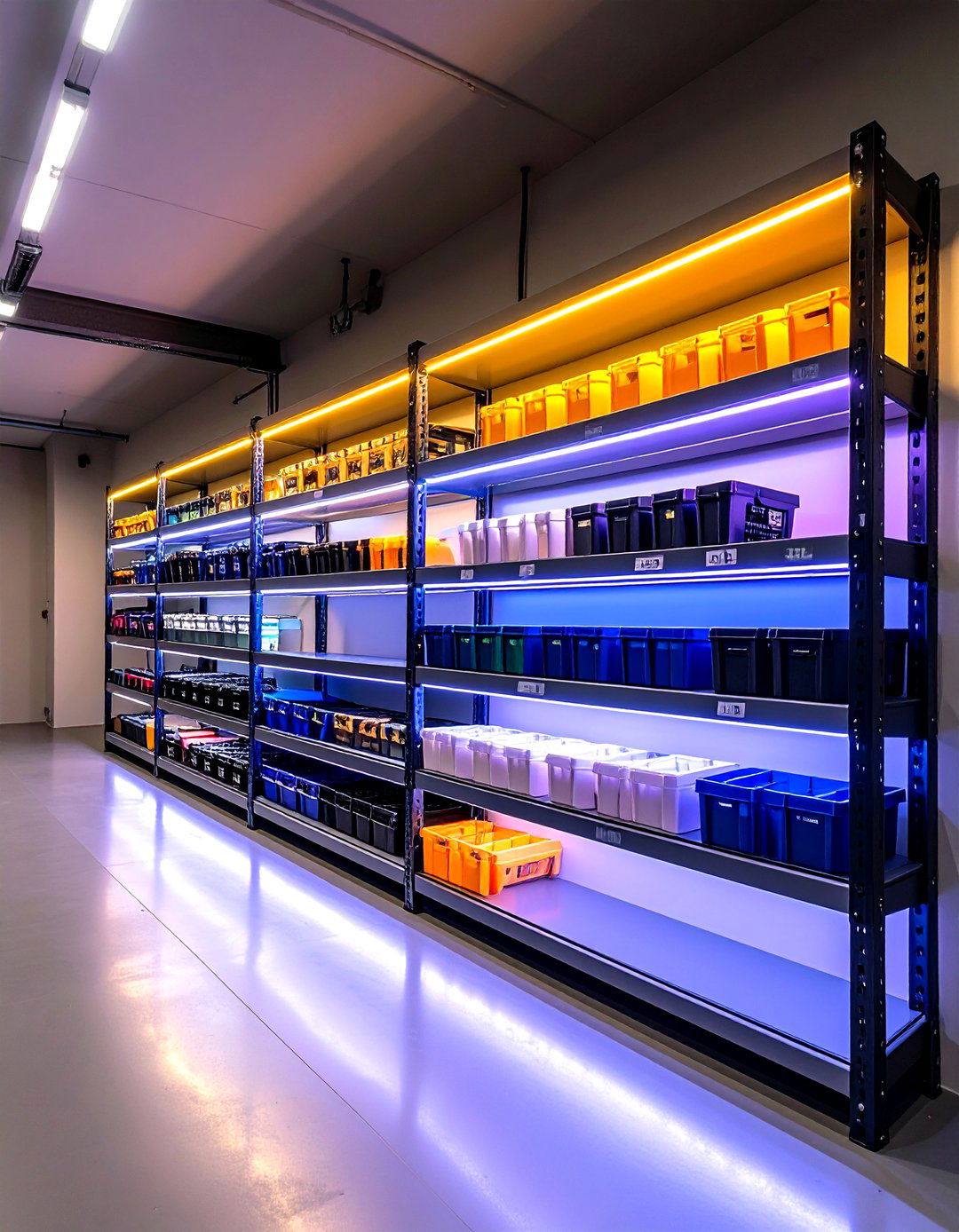
With LED-lit garage shelving, late-night tinkering no longer means balancing a clamp-light between paint cans. Adhesive strip lights tucked beneath each shelf cast shadow-free illumination directly onto bins and labels, making retrieval safer and faster. Many kits now sport waterproof silicone jackets and smart-home compatibility, so you can voice-command a bright-white task beam or dim amber scene as the sun sets. Proper placement matters: run strips two inches in from the shelf’s front edge to hide diodes while washing items in even glow. A five-meter roll typically consumes less electricity than a phone charger yet changes the entire mood.
13. Heavy-Duty Wire Garage Shelving for Industrial Loads
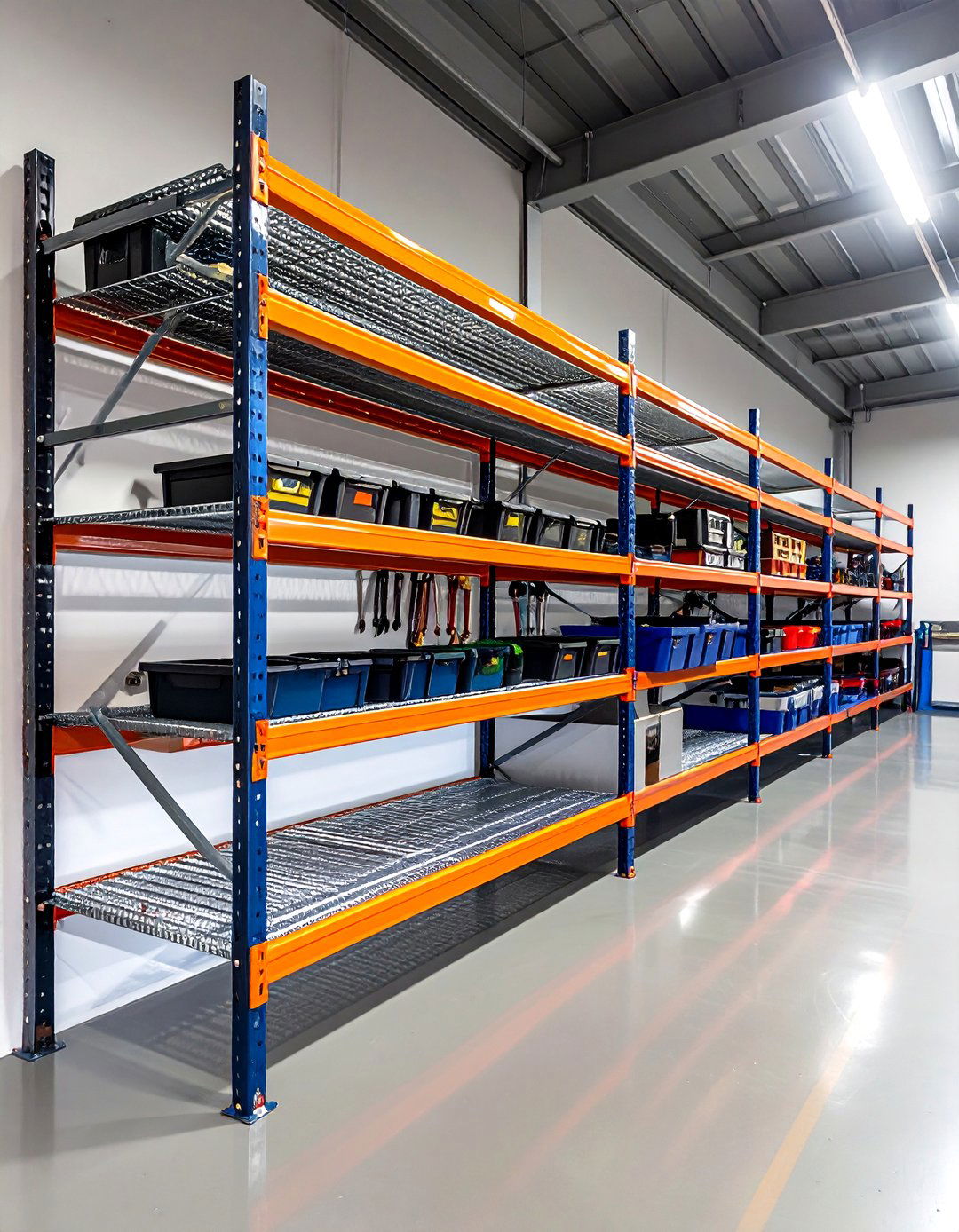
Heavy-duty wire garage shelving earns its keep in households with mechanic-level ambitions. Commercial-grade chrome wire resists oil, solvents, and 500-degree rotor heat while allowing airflow that cools power tools faster. By adding snap-on shelf liners, you prevent small screws from slipping through the grid without sacrificing ventilation. Load limits of 800 pounds per shelf make these racks a match for engine blocks, compressor tanks, and bulk fertilizer. Pro installers recommend tightening split sleeves firmly and checking level with a torpedo before stacking weight; a square start guards against racking under full loads. Once set, these shelves shrug at nearly anything you throw at them.
14. Garage Shelving with Built-In Cabinets and Doors

Garage shelving enclosed by lockable metal cabinets keeps sharp blades, solvents, or collectibles away from curious hands and dust alike. Modern units ride on hidden casters yet offer full-height pegboards inside doors, combining closed security with peg accessibility when open. Adjustable shelves every two inches accept ammo cans one day and camping stoves the next, while integrated power-cord grommets let you charge cordless tools behind closed doors. Choose powder-coated steel for dent resistance and magnetic door latches that won’t jiggle loose during vibration from nearby compressors. An anchor bracket into studs ensures the tall cabinet won’t tip if kids climb.
15. Modular Garage Shelving Systems Grow with You
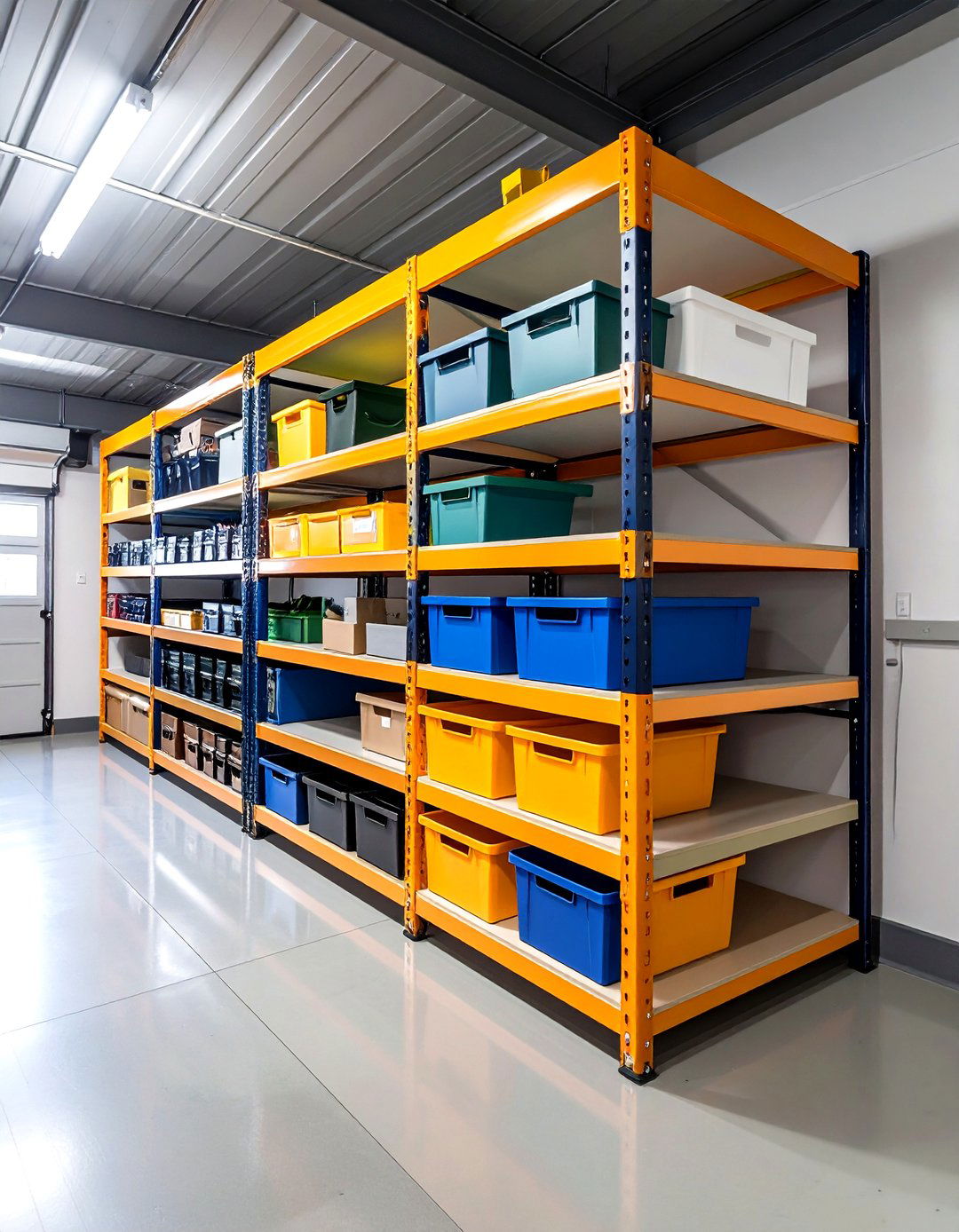
Modular garage shelving systems borrow from living-room bookcases, offering plug-and-play cubes, open frames, and sliding panels that evolve with your hobbies. Engineered connectors make adding a shelf no harder than snapping in an extra leaf, so the system scales from holding hobby paint today to supporting a kayak tomorrow. Designers have introduced eco-friendly composites and sustainably harvested hardwood veneers that give the garage a furnished vibe without sacrificing resilience. By choosing modularity, you future-proof storage and keep fasteners, boards, and seasonal gear visually aligned, avoiding the Frankenstein look of mismatched stand-alone racks.
16. Over-Workbench Garage Shelving Streamlines Projects
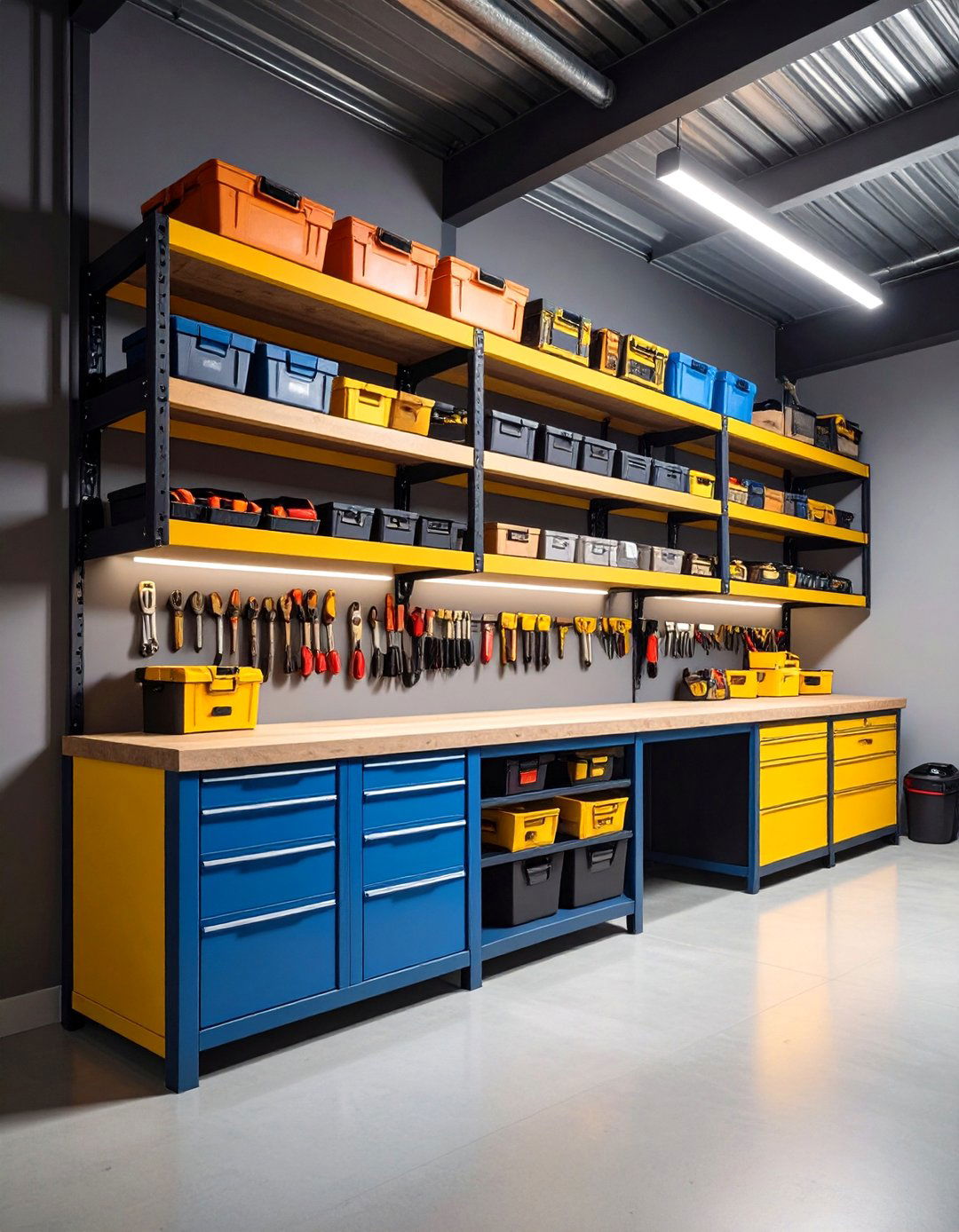
Over-workbench garage shelving puts consumables exactly where projects happen, trimming steps and frustration. Mount shallow, eight- to ten-inch-deep shelves a foot above the pegboard tool zone to hold glue, finish cans, and fast-grab hardware organizers. Because depth is limited, items stay one row thick, eliminating the need to dig behind clutter. Add a lip or small dowel to prevent vibrations from pushing bottles off when you fire up the orbital sander. Task lighting installed underneath brightens the bench while doubling as an accent. This focused approach turns the back wall into a vertical cockpit that streamlines every build.
17. Gear-Tower Garage Shelving for Sports Equipment
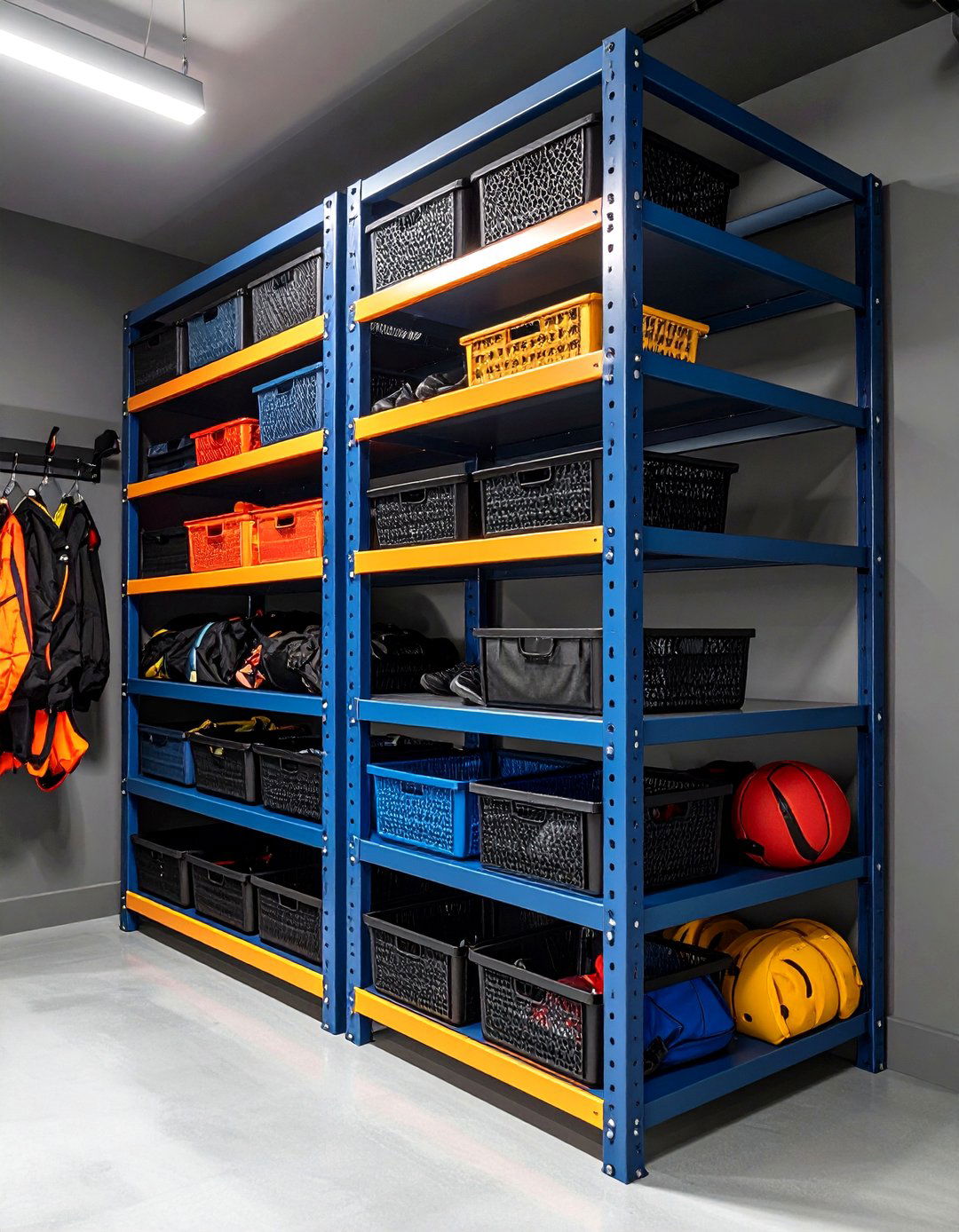
Gear-tower garage shelving corrals sports chaos into a single vertical footprint. Tall side frames host mesh baskets for balls, angled hooks for bats, and deep shelves for helmets, letting sweaty kids unload gear in seconds. Build or buy a tower with ventilated panels so wet pads air-dry overnight, cutting odors. When the season changes, swap soccer balls for snow boots without reassembling the structure. Labeling each tier fosters accountability and turns cleanup into a game for youngsters. Families report reclaiming trunk space and trimming departure time once everything has a dedicated, breathable home.
18. Garden-Nook Garage Shelving for Outdoor Tools
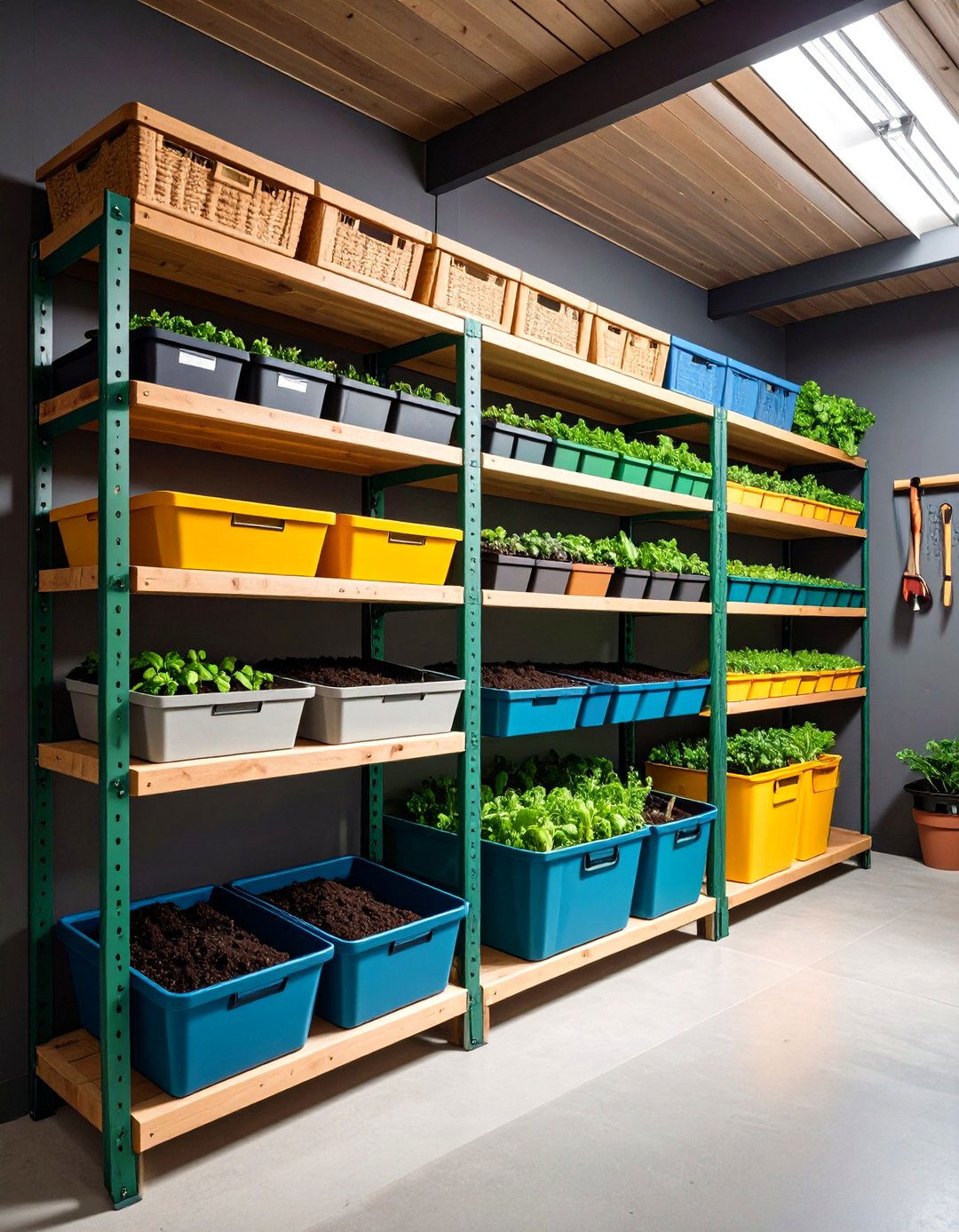
A garden-nook garage shelving arrangement dedicates one end of the bay to rakes, potting soil, and fertilizer, keeping delicate seedlings apart from motor fumes. Start with a slanted lower tray for muddy pots, then add mid-height shelves for seed packets in moisture-proof boxes and a top tier for rarely used pesticides under lock. Install a narrow pegboard strip along the side to hang hand trowels and pruning shears. By clustering all gardening essentials, you avoid cross-contaminating chemicals with household goods, and every spring starts with an instant inventory of supplies.
19. Upcycled Wood Garage Shelving for Eco-Friendly Storage

Upcycled wood garage shelving marries sustainability with character. Salvage pallet boards or leftover framing lumber, plane them smooth, and brace with steel angles for industrial chic that costs next to nothing. Applying a clear matte sealer preserves saw marks and stamps, turning each shelf into a conversation piece while blocking moisture. To keep safety on par with aesthetics, avoid untreated railroad ties—creosote leaches—and use structural screws rated for shear loads. Mixing reclaimed wood with black pipe supports evokes a loft look that enlivens even mundane storage of paint cans or camping coolers.
20. Zone-Based Garage Shelving Layout for Efficiency
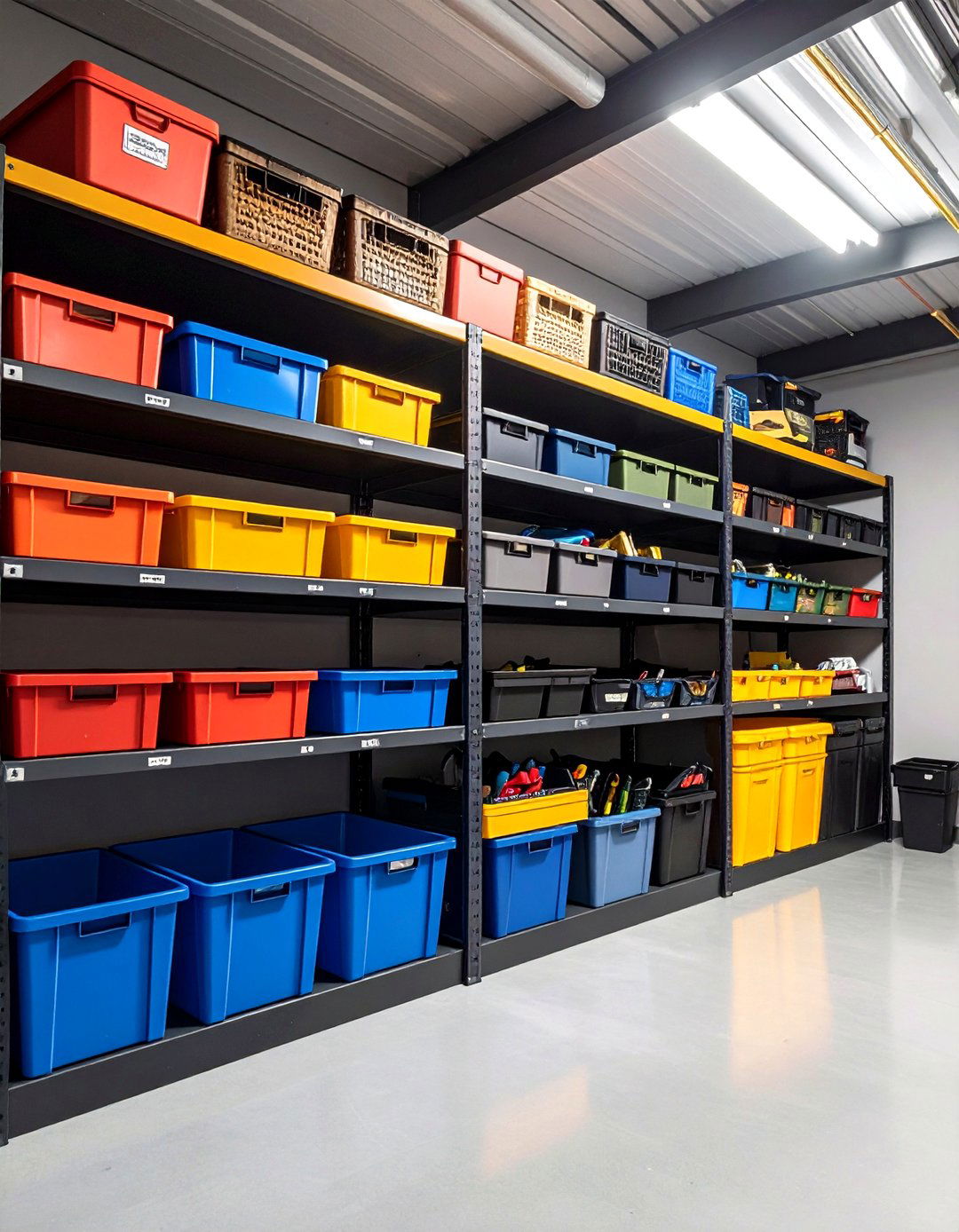
A zone-based garage shelving layout divides the space into clear clusters—automotive, lawn care, hobbies—so every item lands where you instinctively look first. Start by mapping activities, then assign color-coded bins and shelf labels to each zone. Roll-out carts act as bridges, temporarily relocating tools between stations without permanent clutter creep. Experts note that establishing zones lowers search time and discourages stacking randomness in open corners. Regular five-minute resets at day’s end keep the system humming, transforming the garage from a dumping ground into an efficient satellite workshop.
Conclusion:
Organized garage shelving isn’t just about stacking boards—it’s a strategic blend of wall, ceiling, and mobile solutions that adapts to changing passions and seasons. When you match shelf style to load, moisture, and workflow, you reclaim neglected cubic feet and cut project setup time dramatically. From heavy-duty wire racks to folding pop-ups, each idea above offers a tested pathway toward a safer, more inspiring workspace. Pick one to start, build momentum, and watch how a tidy garage fuels creativity in every corner of home life.




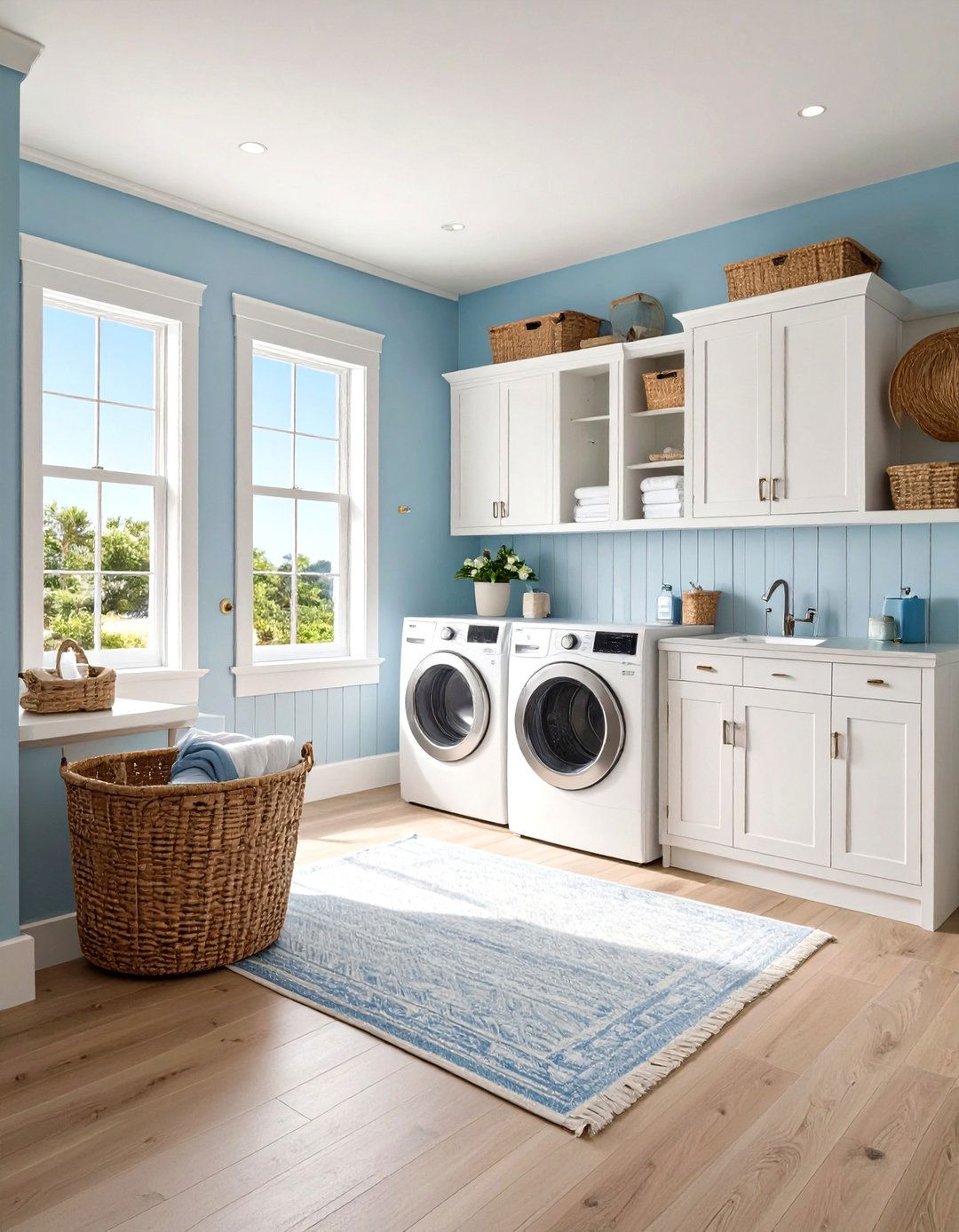
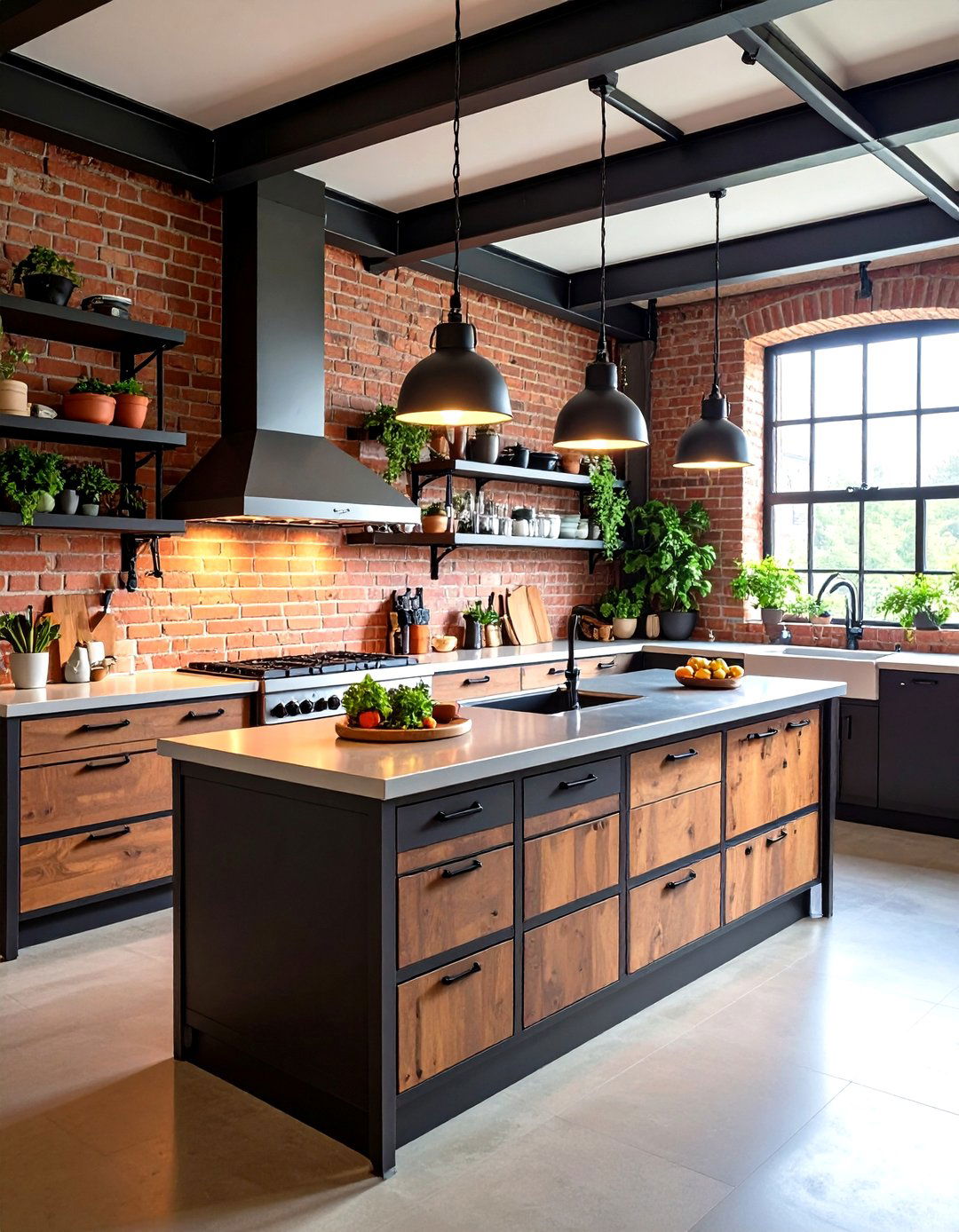

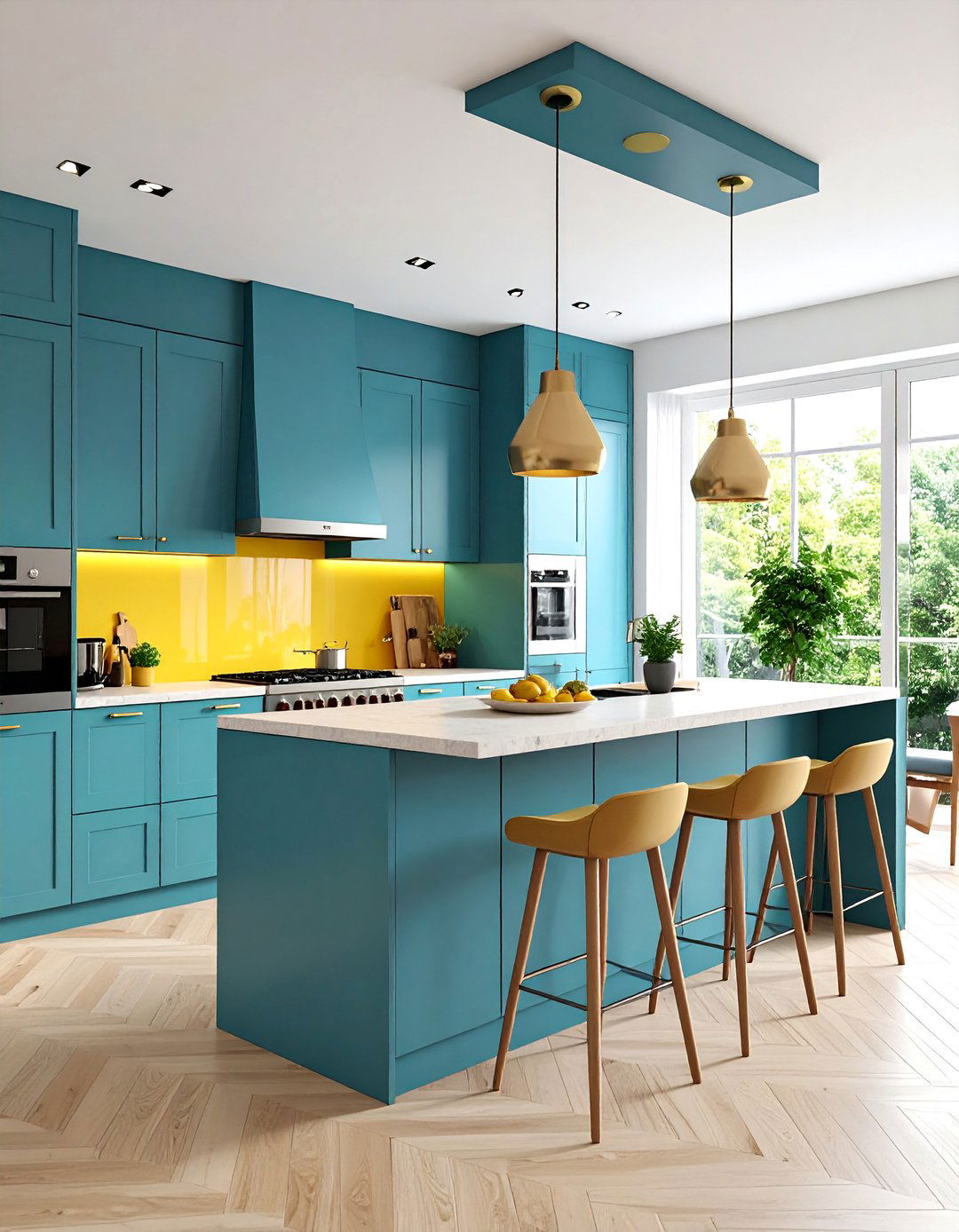
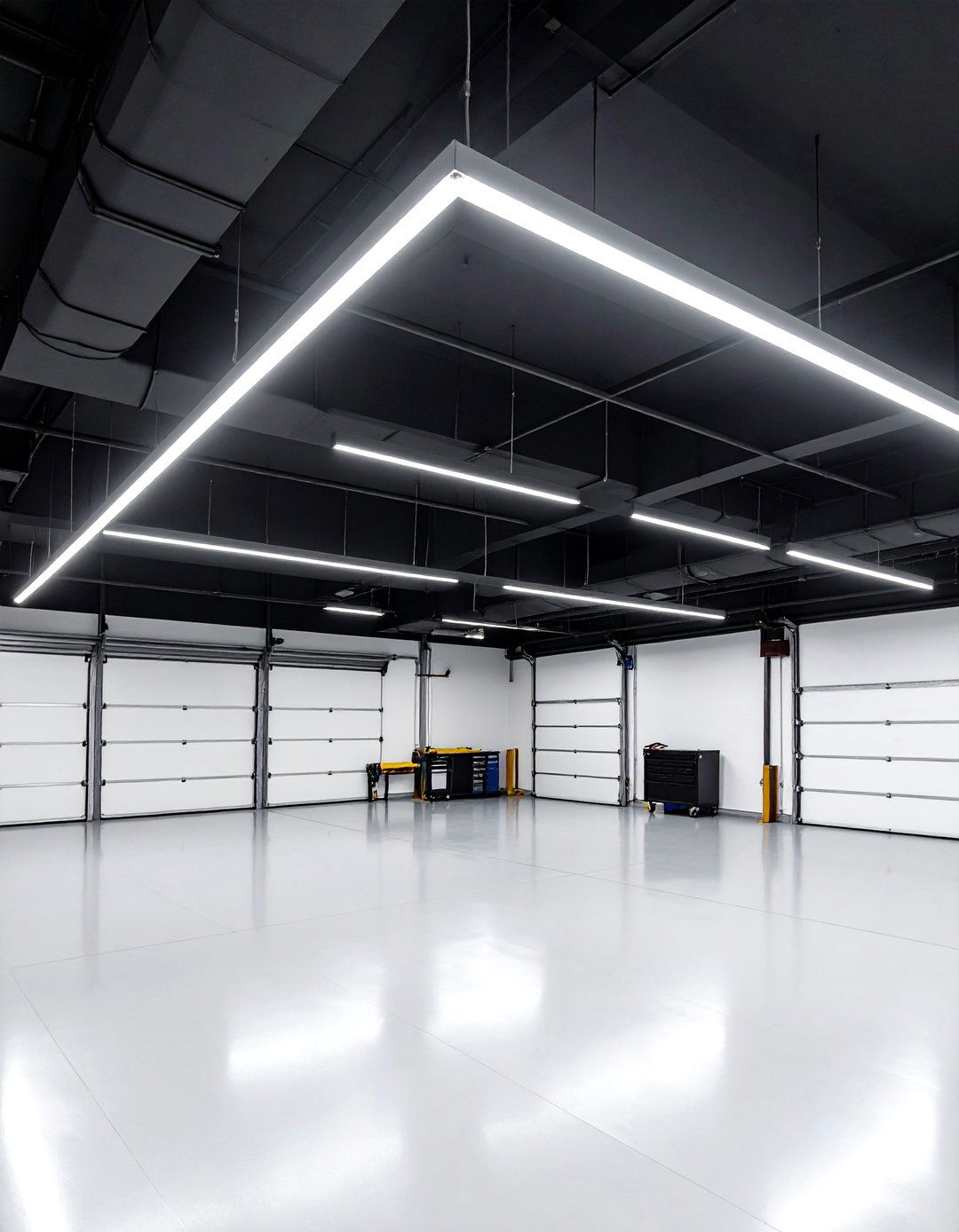

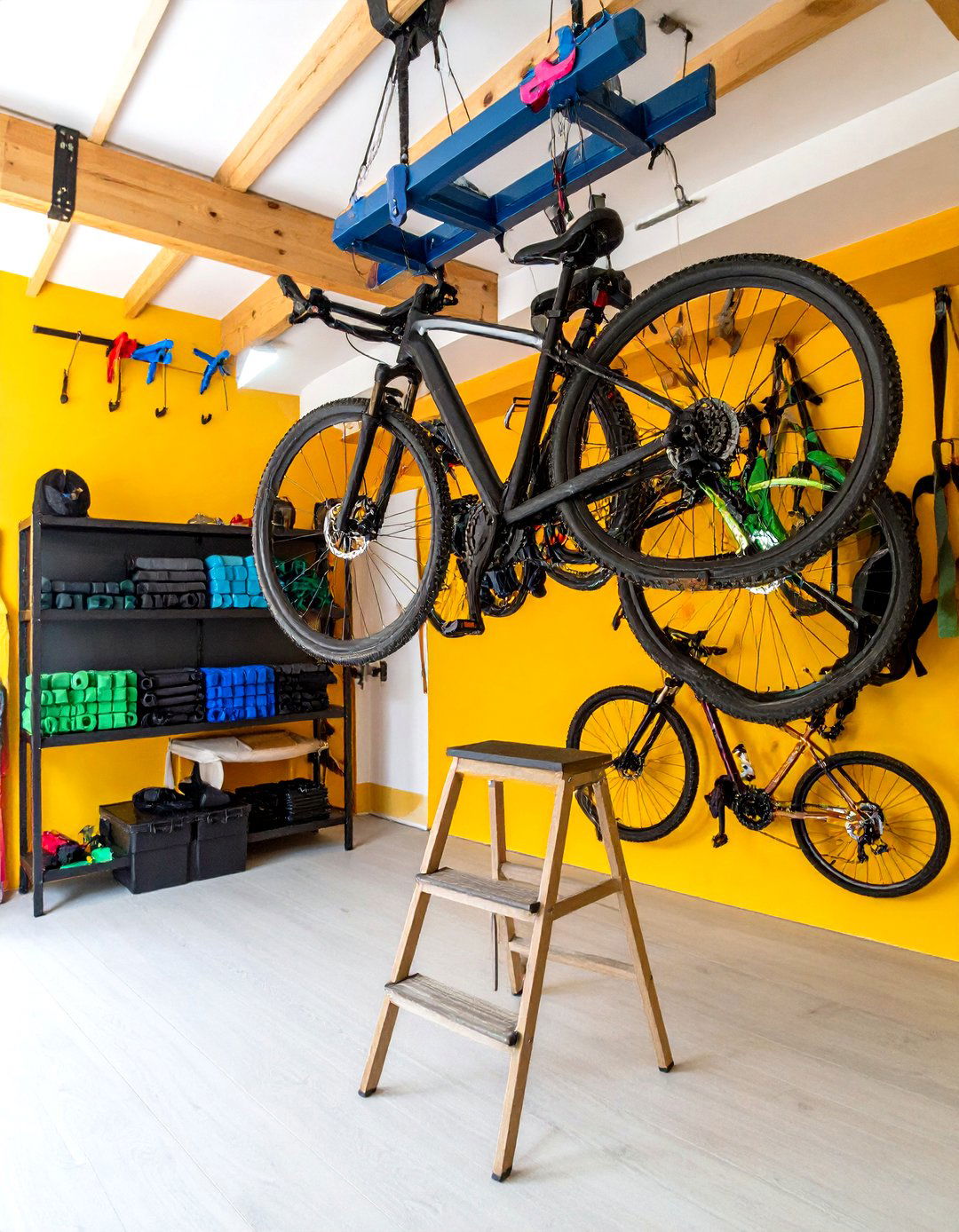
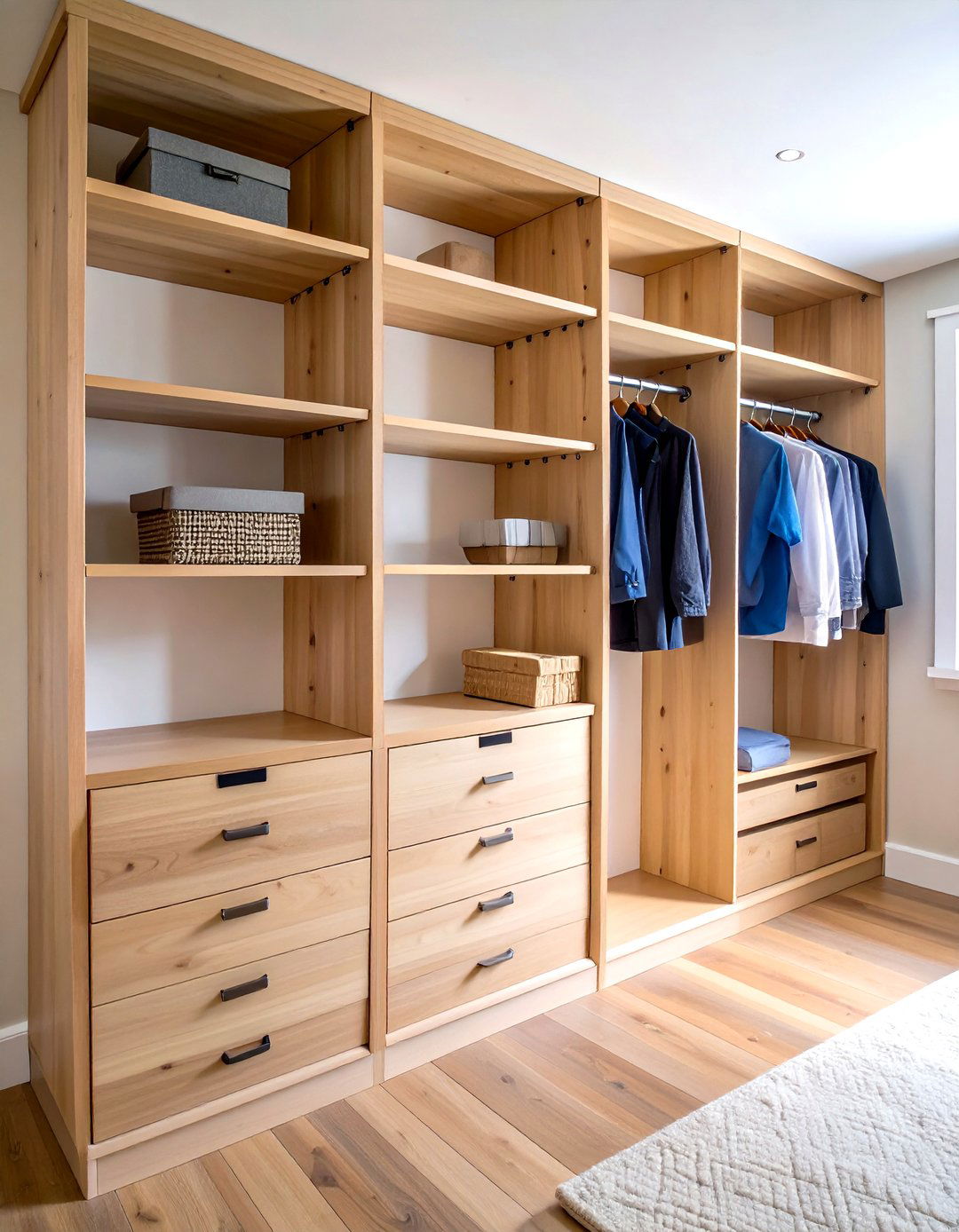
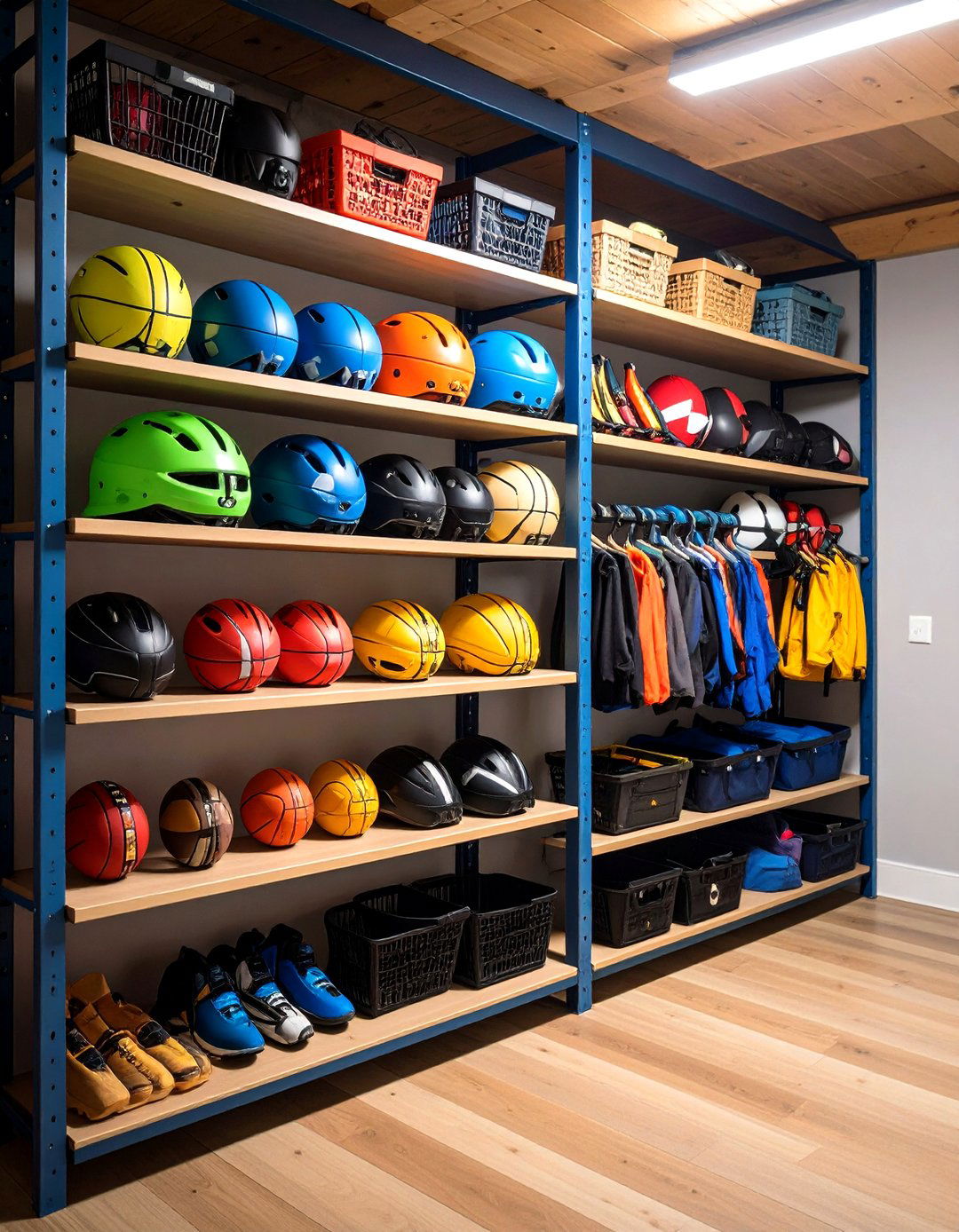
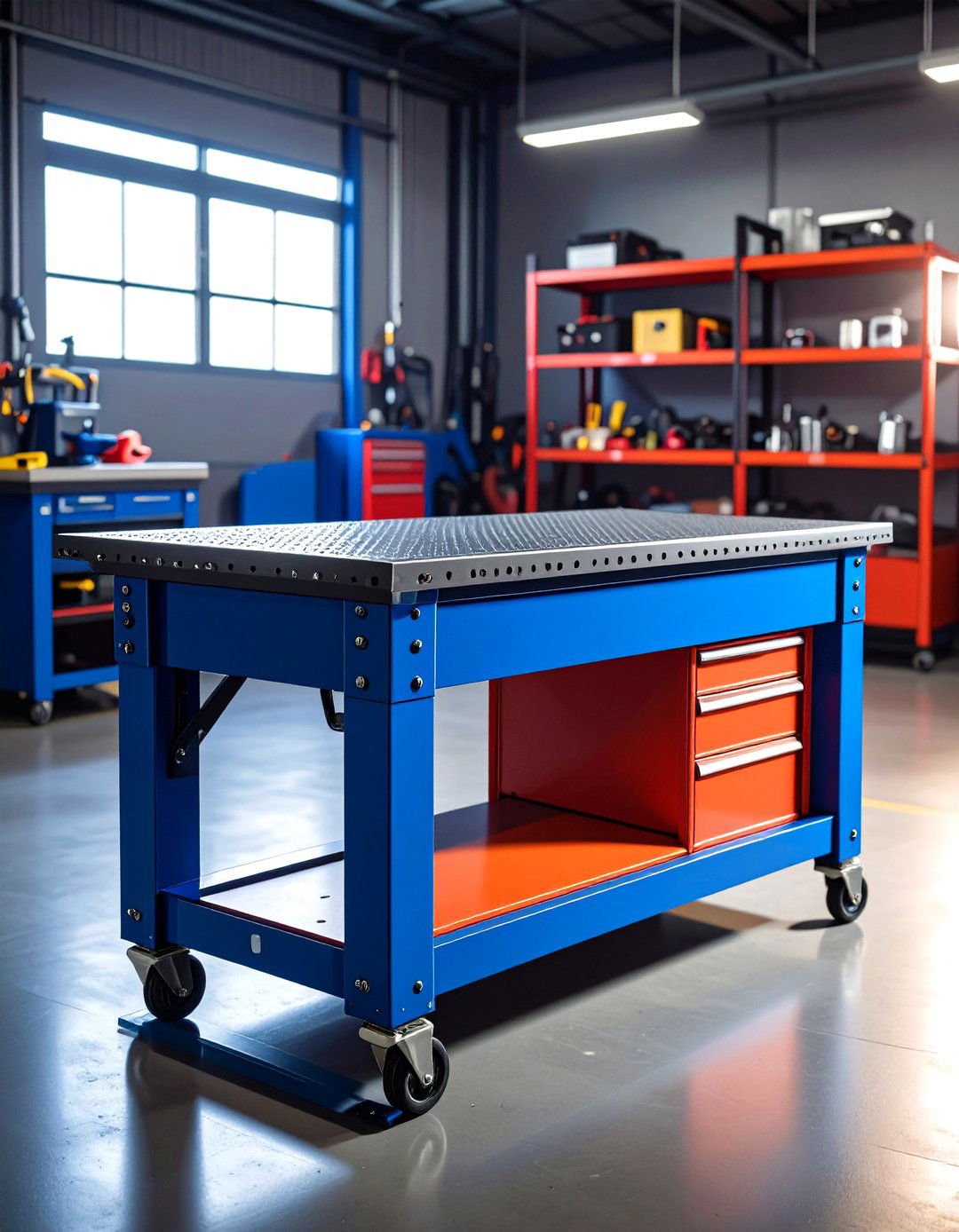


Leave a Reply